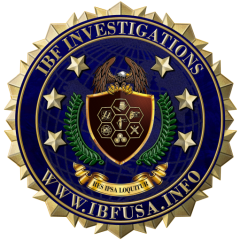
This article was written for, and originally appeared on www.arrivealive.co.za and on www.truckandfreight.co.za.
Every year, during the December Holidays, we wait with bated breath to hear the latest horror statistics that invariably come out as holiday makers rush to the coast or their respective destinations.
In the lead-up to this, we hear a lot from Government and Law Enforcement Agencies about their plans and programs. The narrative invariably includes “zero tolerance” and “deployment on national roads.” Once again, the Government announced, on 4 December 2023 already, that “Traffic officials will be out in full force during this period and will enforce a zero-tolerance approach to any violation of our traffic regulations.”
Despite their best efforts, sincerest commitments, and despite previous statistics, the results are almost always disappointing. For some reason people simply seem not to be willing to take active steps to safeguard us all.
To get the low-down on exactly what the roads were like during the 2023/24 holiday season, we approached Stan Bezuidenhout from IBF Investigations for feedback. Stan is an internationally recognized crash expert with more than 23 years’ experience locally and in other countries, and he spent a lot of time on the roads as he was appointed in a variety of cases from Durban to Cape Town and in-between.
These are his thoughts, based on his experiences over December 2023 and into January 2024, as he negotiated multiple national roads in South Africa numerous times:
As a Forensic Specialist, I am regularly appointed to investigate or analyse crash cases all over South Africa, and I prefer to travel by road. I could fly, but I need to take along a lot of equipment and I can get calls in remote locations on very short notice, forcing me to change my routes or re-plan my travels to accommodate evidence preservation pressures.
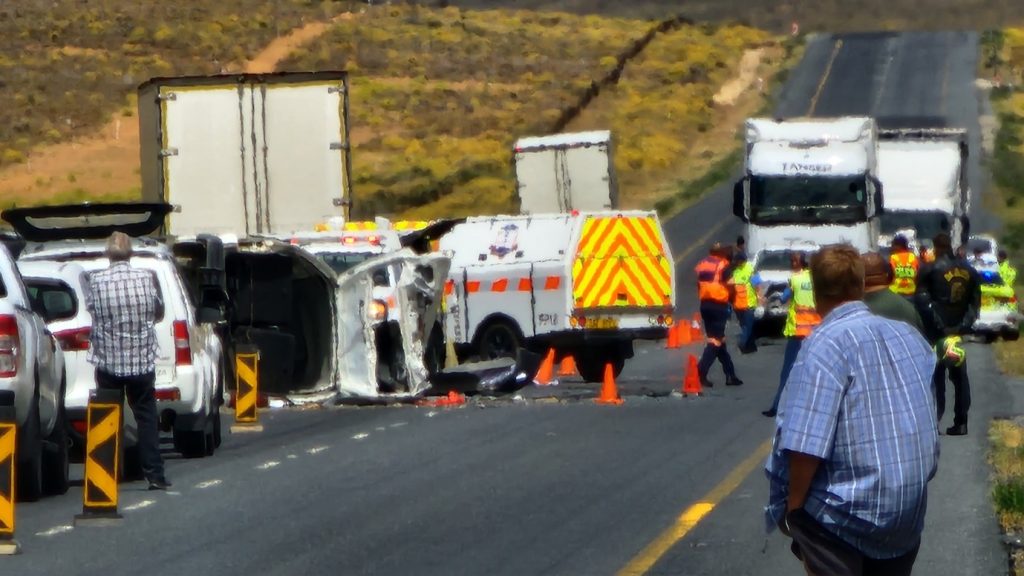
This December/January, I was exceptionally busy. I literally travelled from Johannesburg to Durban via the N3 and via Johannesburg and Cape Town via the N1 numerous times – sometimes having been back in Johannesburg no more than 2 days.
Since I can only speak for my own personal experience, as far as the conditions and traffic actions are concerned, I regard my anecdotal examples to be sound on account of how regularly I travelled.
I’d like to start with the issue of my expectations. I know that Government has introduced a variety of “solutions” or “efforts” over the last, say, ten years that they invariably punted as valuable contributors in the promotion of road safety. The National Traffic Police Unit was established by the Road Traffic Management Corporation (the RTMC). This is a n additional resource that was deployed in conjunction with the South African Police, Provincial Traffic Units, Law Enforcement Units, other Traffic Police Units, and Local Traffic and METRO Police units.

In 2010, Transport Minister Sibusiso Ndebele committed to establishing a specialized National Intervention Unit (NIU) to bolster operations and interventions of existing traffic law enforcement agencies in dealing with, particularly, high accident frequency locations. By March 2011, 231 Traffic Officers who form part of the first batch of recruits for the NIU, underwent specialised training at the Tshwane Metro Police Academy and Boekenhoutskloof Traffic Training College in Pretoria.
In addition to the compulsory six-month traffic officer’s training, members of the NIU also received training in various other courses including first aid, interpersonal communications, defensive driving, anti-corruption, ethics, dealing with people with diplomatic immunity, and incident management.
The NIU, under the command of the Road Traffic Management Corporation (RTMC), was formed to engage in joint operations with various law enforcement agencies such as provincial traffic, municipal/metro police, South African Police Service (SAPS), Cross Border Transport Agency, Military Police, South African Revenue Service (SARS), Immigration and Environmental Affairs to empower, share and transfer skills.
The unit is also mandated to assist in stabilizing identified locations through special blitz/sting operations and was earmarked for deployment across the country as and when required either at the invitation of a specific law enforcement agency or as a result of national deployment. The NIU utilizes state-of-the-art equipment including breathalyzers with drug detection devices, number plate recognition equipment, mobile violation recorders, and speed-timing equipment.

By February 2023, the National Government announced that about 250 new traffic officers will be deployed nationally on the roads to bolster the number of traffic officers who will enforce the rules of the road, as well as protect and serve the nation.
“These are physically fit officers, and we think they will play a critical role in ensuring safety on our roads. We have trained them on all aspects of road safety, and we think that this cohort will make a decisive impact on road fatalities and road crashes,” Road Traffic Management Corporation (RTMC) Spokesperson, Simon Zwane, said during an interview with SANews.
Depending on the operational requirements, the traffic officers will be deployed in areas of high need to assist in bringing down the number road accidents. They ensure that all road users, including pedestrians, use roads in an orderly and safe manner.
Interestingly, the key purpose of traffic officers was touted to be to ensure the safe and free flow of traffic, and to prevent road crashes and deaths on the roads.
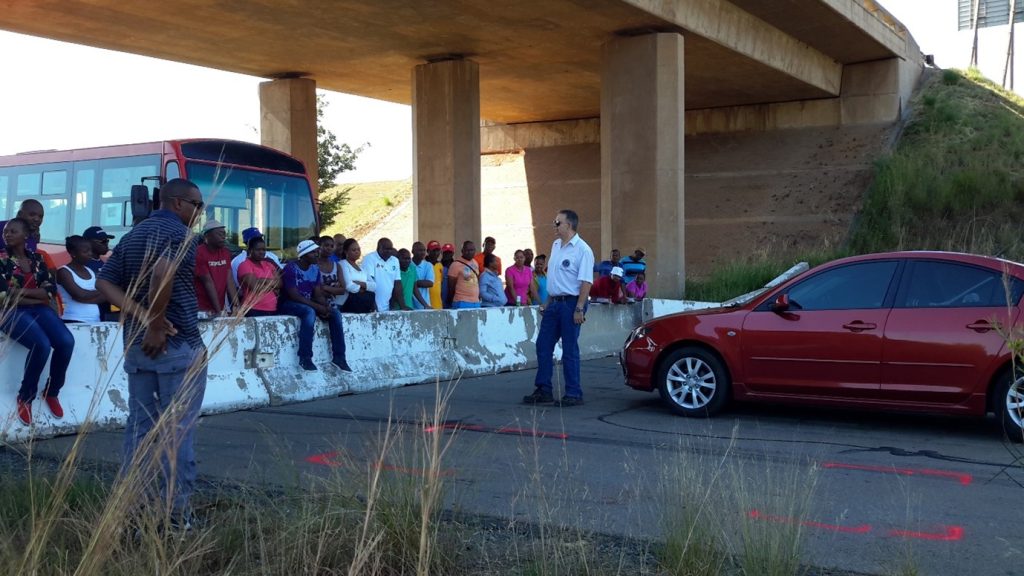
So committed were they to this objective that I was engaged to train over 40 of their members in 2015. I provided at-scene and post-event crash investigation training and exposed them to practical examples. I considered the training a success, but the RTMC soon head-hunted several high-ranking Law Enforcement Officials from other departments and they currently provide training to their own members.

In September 2023, Renault South Africa announced their partnership with prominent entities such as the Road Traffic Management Corporation (RTMC) and Bakwena N1N4 Toll Road Concessionaire (Bakwena), which are dedicated to the cause of road safety. A fleet of twelve vehicles were handed over to these entities. The provision of six branded Renault Captur vehicles promised to stand the organization in good stead in bolstering their efforts and strong presence on the N3 routes over the critical festive holiday period, in order to instill responsible road usage behavior.
The supply of six branded Renault Clio vehicles to Bakwena, was also intended to boost their existing route patrols over the festive period and to assist with route surveillance, and crash scenes as well as providing road users in distress with assistance.
On 12 September the Western Cape Government also officially handed over 31 (out of 122) specialised high-performance vehicles to their Provincial Traffic Law Enforcement officers. The remaining vehicles were rolled out across the Western Cape over the weeks that followed, as a substantial boost to safety ahead of the festive season and upcoming school holidays.

These vehicles – which replace existing patrol vehicles in the fleet – have been converted and optimised for the rigours of traffic law enforcement on our provincial and national roads. This enhances the safety of our officers and empowers them to make our roads and communities safer. The vehicles are equipped with in-vehicle technology, including automatic number plate recognition (ANPR) cameras, which interface directly with the National Traffic Information System (NaTIS); providing officers with critical information within seconds.
With all this done, and more, I would have expected to see visible enforcement efforts all along major routes. Since heavy traffic makes excessive speeding more difficult and since dangerous driving, illegal overtaking, overloading, and reckless actions are likely greater risks, I expected the focus of law enforcement to be on rolling violation enforcement, early intervention, and traffic pattern recognition – all as early interventions.
To my dismay, I saw very little done, other than the very occasional roadblock where I am simply asked for my driving license before I was allowed to carry on. Even speed enforcement was not as prevalent as I have seen at other times. In my experience – anecdotal as it may be – I don’t think my speed was measured more than perhaps 5 times in all my travels!
While the RTMC was very committed to “ensure the safe and free flow of traffic, and to prevent road crashes and deaths on the roads,” my wife and I actually verbally commented on how few of their vehicles we saw on the roads. We might have seen three in more than perhaps over 20,000Km of travel during December/January alone!
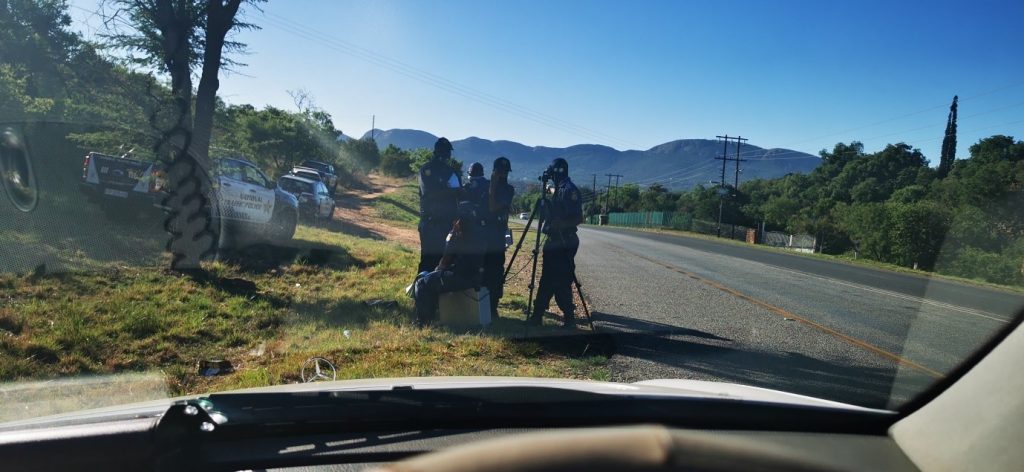
On the other hand, I have personally observed them – between Hartbeespoort and Brits – conducting speed trapping on the R511 and just outside Hartbeespoort on the opposite side, also on the R511. In the latter, on confrontation, they actually admitted to me that they were issuing fines to people for exceeding a speed of 60Km/h in a section of road where the posted speed limit was 60Km/h while there were some five or more vehicles deployed in the latter. In that case, their officers were dressed in black uniforms, standing under the shade of trees, and running out in front of moving vehicles – or rather, speeding vehicles – to stop them!
When I confronted the officers on the risks of doing this, and questioned why they were not properly dressed in Personal Protection Equipment (PPE) in the form of Reflective Overwear, I was promptly accused of “interfering in their duties!”
To be brutally honest, my impression of road safety efforts by law enforcement – even over the festive season – is focused too heavily on revenue generation and not nearly enough on risk mitigation or the reduction of crashes or fatalities. I may be wrong – there may be government officials who are not interested in revenue as much as my experience suggests, but I am not certain who they are or where they are operating.
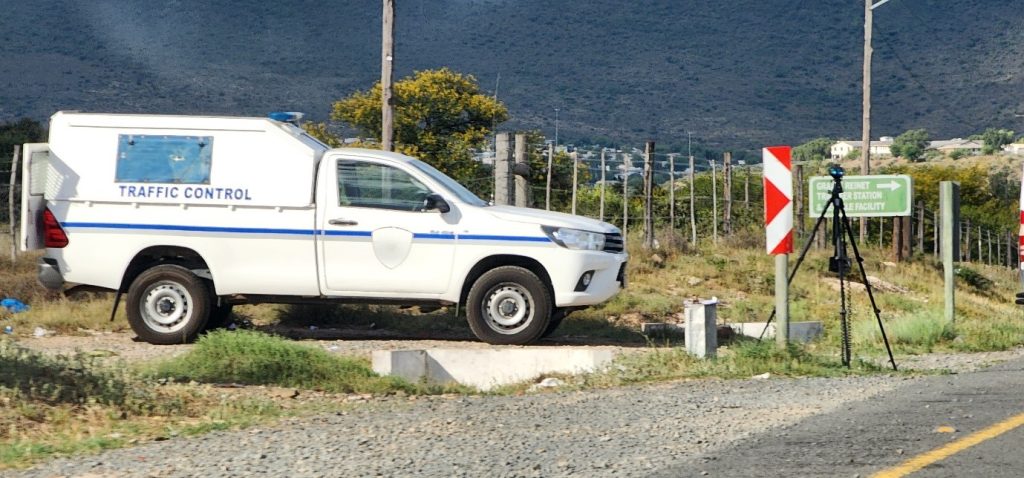
Don’t get me wrong. I don’t condone excessive speeding. But if all you see for thousands of kilometres over almost a month, on South African Roads, are vehicles parked with speed cameras next to them, or roadblocks where your number plate is read and where the officers do little more than act as debt collectors, you have to ask what the true motivations are.
But enough about what is wrong – let’s take a look at what we can do to solve this problem, to everyone’s advantage. To my interest, I specifically noted that heavy commercial vehicles were regularly involved in collisions, seemingly caused a lot of traffic friction, and resulted in as many as hundreds of vehicles becoming “trapped” behind them, to the frustration of their drivers, and to the point where they act very recklessly to “solve the problem…” Here are some of the most dangerous actions I have seen on the road, along with some advice on how truck drivers or other road users can act to reduce risk, avoid carnage, and get home safely, with special consideration for the challenges faced by heavy commercial vehicles, while traveling for holidays:
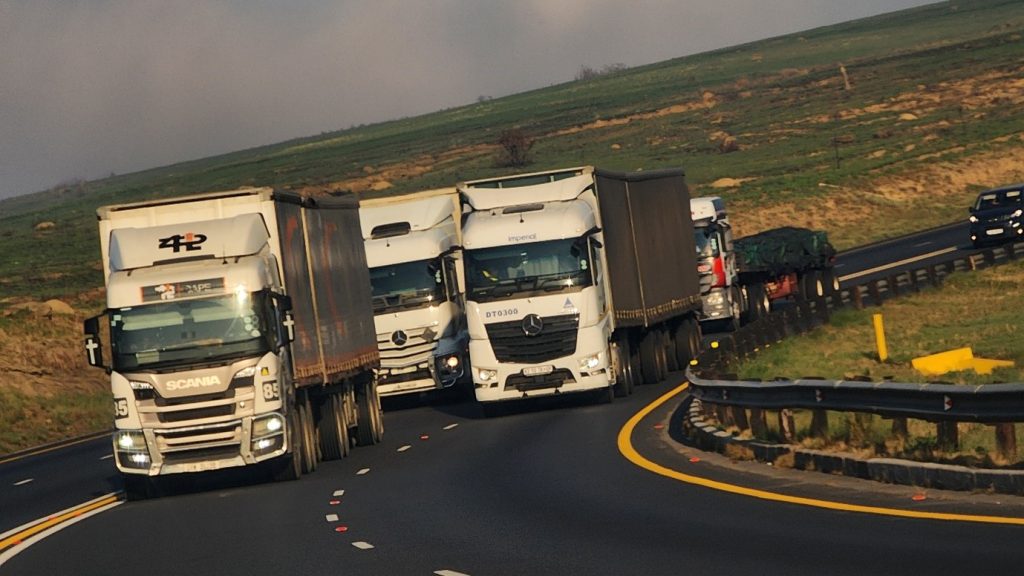
Example: Semi-trucks squatting in a lane without allowing faster traffic to pass can lead to congestion, frustration, and unsafe passing maneuvers by other drivers. Truck drivers should use designated slower lanes, and if in the right lane, move to the left to allow faster vehicles to pass. Other road users should exercise patience, maintain a safe following distance, and use legal opportunities to pass.
Example: Prolonged overtaking by semi-trucks with minimal speed differences can impede traffic flow, leading to frustration and increased chances of unsafe passing attempts. Truck drivers should execute overtaking maneuvers efficiently, ensuring minimal disruption to traffic. Other drivers should avoid aggressive overtaking and be patient, waiting for clear and safe opportunities.
Example: Driving too close to other trucks while preparing to overtake can obstruct traffic, creating a bottleneck effect for many miles. Truck drivers should maintain safe following distances and plan overtaking maneuvers with consideration for surrounding traffic. Other drivers should stay alert, avoid tailgating, and patiently wait for overtaking to be completed.
Example: Semi trucks driving closely together hinder the ability of faster vehicles to overtake individual trucks, leading to traffic congestion. Truck drivers should leave sufficient space between vehicles to allow for safe overtaking. Other road users should anticipate such situations, exercise patience, and take advantage of clear opportunities to pass.
Example: Overtaking in the face of oncoming traffic creates significant hazards, forcing other road users to drive on shoulders for safety. Truck drivers must adhere strictly to safe overtaking practices and never attempt maneuvers that compromise the safety of oncoming traffic. Other drivers should not succumb to pressure, maintain their lanes, and report unsafe driving behavior.
Example: Trucks being used as a weapon to intimidate or delay other road users pose a severe safety threat, potentially leading to accidents and road rage incidents. Law enforcement should take swift action against aggressive driving behaviors. Road users should report such incidents to authorities, maintain a safe distance, and avoid engaging with aggressive drivers.

While this addresses the issue of how trucks affect traffic flow in a variety of ways, road users often react by becoming enraged. Road Rage is a very dangerous phenomenon that can literally drive people to the level of criminal conduct or even dangerous attempts to “punish other road users,” or even to escalate to the point where they can face very serious charges, like reckless driving, culpable homicide, or even murder.
Here are the stages of road rage that people can intentionally anticipate or look out for, and the steps they can take to govern their own actions proactively:
Trigger: Negative past driving experiences may contribute to heightened frustration and impatience. Reflect on past experiences and consciously adopt a calm and patient mindset before embarking on a long road trip.
Trigger: Observing unlawful actions by fellow road users can provoke irritation and anger. Focus on your own adherence to traffic laws, and try to accept that you cannot control the behavior of others. Report severe violations to authorities rather than letting frustration escalate.
Trigger: Perceiving a lack of law enforcement presence may lead to a feeling of lawlessness on the road. Recognize that law enforcement may not always be visible, but it is still active. Stay committed to responsible driving, irrespective of immediate monitoring.
Trigger: Inconsiderate behavior by fellow drivers, such as cutting off or tailgating, can fuel anger.
Foster empathy by considering that other drivers might be dealing with challenges. Avoid retaliatory actions, and focus on maintaining your own safe driving habits.
Trigger: Negative perceptions based on the make or model of certain vehicles can lead to biased judgments. Challenge stereotypes and recognize that driving behavior varies widely among individuals. Avoid generalizations based on the appearance of vehicles.
Trigger: Regularly witnessing unlawful actions by specific classes of vehicles, like Taxis, may breed resentment. Acknowledge that individuals, not entire classes of vehicles, are responsible for actions. Report consistent violations rather than attributing them to a broad category.
Trigger: Direct encounters with intentional aggressive actions by other road users can evoke fear and anger. Stay calm, avoid escalation, and prioritize safety. Report severe incidents to law enforcement.
Trigger: Fatigue, medication, or mental conditions can heighten emotional responses and impair judgment. Ensure adequate rest before long trips, avoid driving under the influence of medications that may impact alertness, and seek professional help for mental health concerns.
Trigger: Challenging road conditions and adverse weather may increase stress levels. Adjust driving speed to match conditions, maintain a safe distance, and stay focused on controlling your own vehicle.
Trigger: Heavy traffic and jams can test patience and contribute to frustration. Plan routes to avoid peak congestion times, use traffic apps for real-time updates and accept that delays are part of driving.
Trigger: Encounter with individuals displaying psychopathic or narcissistic traits and a propensity for rage can be unsettling. Stay vigilant, avoid confrontation, and report severe incidents to law enforcement. Focus on personal safety.
Here’s how you can act when you detect road rage from others:
Stay Calm: If faced with road rage, remain calm, and avoid engaging in aggressive behavior.
Avoid Eye Contact: Minimize potential confrontation by avoiding prolonged eye contact with an aggressive driver.
Maintain Distance: Increase your following distance to create a safety buffer.
Ignore Provocation: Do not respond to insults or provocations. Focus on de-escalation.
Use Technology: Use hands-free devices to report aggressive behavior to law enforcement, providing vehicle details and locations.
Seek Help: If threatened, drive to a public place, contact authorities, or drive to the nearest police station.
By understanding the triggers and employing preventative strategies, road users can contribute to a safer driving environment. In situations of road rage, prioritizing personal safety and employing de-escalation tactics are key to avoiding potentially dangerous confrontations.
Let’s hope that, in 2024, public education will take a front seat, that law enforcement will focus more on service and less on revenue generation, and that road users will become more tolerant, calm, and respectful of others.
